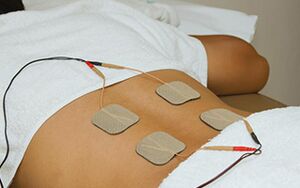Microcurrent Electrical Neuromuscular Stimulation: Difference between revisions
m (editing) |
m (addiing link) |
||
| Line 6: | Line 6: | ||
</div> | </div> | ||
== Introduction == | == Introduction == | ||
[[File:R.jpg|thumb]] | [[File:R.jpg|thumb|[[Microcurrent Electrical Neuromuscular Stimulation#/media/File:R.jpg|R - Microcurrent Electrical Neuromuscular Stimulation - Physiopedia (physio-pedia.com)]]]] | ||
Microcurrent Electrical Neuromuscular Stimulation (MENS) was developed as a physical therapy modality delivering current in the microampere range. It has been reported that MENS has several physiological effects such as pain relief ([https://www.ncbi.nlm.nih.gov/pmc/articles/PMC4424458/ Larner and Kirsch, 1981]) and facilitation of tissues repair including tendon injuries ([http://www.jms.periodikos.com.br/article/587cb4677f8c9d0d058b465f Nessler and Mass, 1987; Owoeye et al., 1987]) and skin ulcers ([https://academic.oup.com/ptj/article-abstract/56/3/265/4568106 Gault and Gatens, 1976; Wolcott et al., 1969]), wounds ([https://www.ncbi.nlm.nih.gov/pmc/articles/PMC4424458/ Byl et al., 1994; Huckfeldt et al., 2007]), bedsores ([https://www.researchgate.net/profile/Patrick-Carley-2/publication/ccccc-446/links/572cc8ff08ae7441518e64ab/Carley-P-J-Wainapel-S-FElectrotherapy-for-acceleration-of-wound-healing-low-intensity-direct-current-Arch-Phys-Med-Rehabil-66-443-446.pdf Carley and Wainpel, 1985]) . | Microcurrent Electrical Neuromuscular Stimulation (MENS) was developed as a physical therapy modality delivering current in the microampere range. It has been reported that MENS has several physiological effects such as pain relief ([https://www.ncbi.nlm.nih.gov/pmc/articles/PMC4424458/ Larner and Kirsch, 1981]) and facilitation of tissues repair including tendon injuries ([http://www.jms.periodikos.com.br/article/587cb4677f8c9d0d058b465f Nessler and Mass, 1987; Owoeye et al., 1987]) and skin ulcers ([https://academic.oup.com/ptj/article-abstract/56/3/265/4568106 Gault and Gatens, 1976; Wolcott et al., 1969]), wounds ([https://www.ncbi.nlm.nih.gov/pmc/articles/PMC4424458/ Byl et al., 1994; Huckfeldt et al., 2007]), bedsores ([https://www.researchgate.net/profile/Patrick-Carley-2/publication/ccccc-446/links/572cc8ff08ae7441518e64ab/Carley-P-J-Wainapel-S-FElectrotherapy-for-acceleration-of-wound-healing-low-intensity-direct-current-Arch-Phys-Med-Rehabil-66-443-446.pdf Carley and Wainpel, 1985]) . | ||
Revision as of 16:53, 3 December 2023
Original Editor - User Name
Top Contributors - Yahya Al-Razi and Angeliki Chorti
Introduction[edit | edit source]
Microcurrent Electrical Neuromuscular Stimulation (MENS) was developed as a physical therapy modality delivering current in the microampere range. It has been reported that MENS has several physiological effects such as pain relief (Larner and Kirsch, 1981) and facilitation of tissues repair including tendon injuries (Nessler and Mass, 1987; Owoeye et al., 1987) and skin ulcers (Gault and Gatens, 1976; Wolcott et al., 1969), wounds (Byl et al., 1994; Huckfeldt et al., 2007), bedsores (Carley and Wainpel, 1985) .
A type of low voltage current but with stimulus intensity less than 1 milliamp or 1000 microamps.
Low intensity stimulation
Act at the subsensory or very low sensory level
KEY POINTS:
- Microcurrent electrical neuromuscular stimulation (MENS) facilitated the recovery of the relative muscle dry weight, the relative muscle protein content, and the mean cross-sectional areas of muscle fibers of injured TA muscle in mice.[1]
- The number of satellite cells was increased by MENS during the regenerating phase of injured skeletal muscle.
- Decrease in the percentages of fibers with central nuclei was facilitated by MENS.
- MENS may facilitate the regeneration of injured skeletal muscles.[2]
Current specification[edit | edit source]
Type: Direct or Alternating current.
Waveform: A variety of waveforms from modified monophasic to biphasic square waves.
Frequency: Range from 0.3 HZ to 50 HZ.
Pulse duration: may be prolonged at the lower frequencies from 1 to 500 milliseconds.
Biophysical effects[edit | edit source]
Currents below 500 microamps increase the level of ATP passing low amperage electrical current through the tissues, creates an imbalance in the number of protons on either side of the mitochondrial membrane. As the protons move from the anode to the cathode, they cross the mitochondrial membrane causing adenosine triphosphatase to produce ATP.[1]
Therapeutic effects[edit | edit source]
PromotionTissues healing:
Tissues trauma or injury affects the electrical potential of the involved cells which is called injury potential or current of injury and as a result the bioelectrical activity within the injured area is diminished and the cellular function is disrupted so, re-establishing the body's natural electrical balance which allows cell function and increases ATP supply, thus providing the metabolic energy for healing to occur . Cells are stimulated to increase their normal proliferation, migration, motility as well as Stimulation of DNA synthesis and collagen synthesis and Increase receptor level for growth factors.[3]
Analgesic effect:
Make the nerve cell membrane more receptive to neurotransmitters that will block transmission of pain and create or change the constant direct current flow of the neural tissues that may have some way of biasing the transmission of the painful stimulus then restore the biological electrical balance to facilitate tissues healing and subsequent pain control.[4]
Indications[edit | edit source]
- Acute and chronic pain
- Acute and chronic inflammation
- Sprains
- Strains
- Superficial wound healing
- Fracture healing
- Tendon and ligament healing
Contraindications[edit | edit source]
- Pain of unknown origin or undiagnosed pain
- Osteomyelitis
- Exposed metal implants as in external fixation of fractures.
Neurostim Device[edit | edit source]
Neurostim is a device that uses microcurrent stimulation to reduce pain and scar tissue (fascial distortions) by applying it to specific points on the body. It is a needleless form of acupuncture that relaxes muscles. This is very important to re-establish motor control to that area and to deal with the consequences of surgery.
References[edit | edit source]
- ↑ 1.0 1.1 Ohno Y, Fujiya H, Goto A, Nakamura A, Nishiura Y, Sugiura T, Ohira Y, Yoshioka T, Goto K. Microcurrent electrical nerve stimulation facilitates regrowth of mouse soleus muscle. International journal of medical sciences. 2013;10(10):1286.
- ↑ Fujiya H, Ogura Y, Ohno Y, Goto A, Nakamura A, Ohashi K, Uematsu D, Aoki H, Musha H, Goto K. Microcurrent electrical neuromuscular stimulation facilitates regeneration of injured skeletal muscle in mice. Journal of sports science & medicine. 2015 Jun;14(2):297.
- ↑ Yu C, Hu ZQ, Peng RY. Effects and mechanisms of a microcurrent dressing on skin wound healing: a review. Military Medical Research. 2014 Dec;1(1):1-8.
- ↑ Korelo RI, Valderramas S, Ternoski B, Medeiros DS, Andres LF, Adolph SM. Microcurrent application as analgesic treatment in venous ulcers: a pilot study. Revista latino-americana de enfermagem. 2012;20:753-60.







